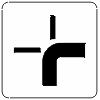 |
||
Hints For The Driving Test
DISTANCE CALCULATIONS:
Be careful on the test when they ask you about reaction time. Reaction time is a function of fatigue, alcohol, drugs, etc. It is NOT a function of the weather. The braking distance will double on a wet road, but the time it takes for you to react will not.
SPEED:
Often in the test, you will be asked at what speed you can drive. Pay attention to the wording of the question. If they ask you what the speed limit is, it's simple. But if the question says "I can drive at..." and lists a bunch of speeds, you will probably need to select more than one answer. For example, if the options are [A] 50 km/hr, [B] 70 km/hr, [C] 90 km/hr, [D] 110 km/hr and you know the speed limit is 90 km/hr, be sure to select [A] and [B] and [C] because those are also valid speeds when the limit is 90 km/hr. An annoying trick of the test, but it comes up a lot and is easy to avoid if you pay attention.
CAR LIGHTS:
Sometimes you are asked what lights you should have on. Pay attention to how the question is worded. For example, let's say the question asks you what lights should be on and you are given the choices 'parking lights', 'low beams' and 'high beams'. If you want to say low beams, don't forget to also select parking lights. Even though no car on the planet lets you turn on low beams without also turning on the parking lights, you must select both on the test or you'll get the question wrong.
CAR LIGHTS:
Even though the official book says that some cars are able to turn on high and low beams independently, for the test you may have only one on at a time. This one actually makes sense because the driving test is based on the Renault Clio, the officially standard Auto École car, and it cannot have both high and low beams on at the same time. They tell you at the beginning of the test to assume you're driving a Clio and you should also have been told this during driving class. This also means that for the test you are able to turn on your front and rear fog lights separately.
COMPLEX INTERSECTIONS:
 Study and understand the "complex intersection" signs. These are the white square signs that show an intersection where the "priority road" turns. There is a high probability of having a question about this type of sign on the test.
Study and understand the "complex intersection" signs. These are the white square signs that show an intersection where the "priority road" turns. There is a high probability of having a question about this type of sign on the test.
|
|